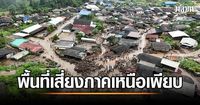On August 30, 2025, a remarkable coalition of government agencies, scientific experts, and private organizations convened in Thailand to address the country’s persistent challenges with water management, flood prevention, and natural disaster mitigation. The meeting, held via Zoom and attended by representatives from twelve organizations, signaled a renewed urgency in tackling the increasing threats posed by flooding and landslides, particularly in the central and northern regions of the country.
At the heart of the discussions was an ambitious memorandum of understanding (MOU) that formalized cooperation between the Department of National Parks, Wildlife and Plant Conservation, the Thailand Diving Association, and other key stakeholders. According to Thai Tabloid, the agreement aims to enhance the exploration and preservation of underwater cave systems—both in marine and inland environments—while simultaneously developing innovative approaches to water resource management and disaster risk reduction.
Mr. Attapol Charoenchansa, Director-General of the Department of National Parks, Wildlife and Plant Conservation, chaired the meeting alongside Admiral Aphakorn Yukongkaew, President of the Thailand Diving Association. The session drew in a diverse array of experts, including Mr. Pallop Krityanawat, an advisor on administrative management, Ms. Rassarin Siriphatphurinun from the Department of Mineral Resources, and the heads of national marine park study and research centers. All participated remotely, underscoring the collaborative and multidisciplinary nature of this new initiative.
The urgency for such a partnership has grown in recent years, as Thailand has grappled with more frequent and severe weather events. Heavy rainfall, rapid urbanization, and deforestation have all contributed to recurring floods and landslides—disasters that not only threaten lives and livelihoods but also place immense strain on the nation’s infrastructure and natural resources. The meeting’s participants recognized that addressing these threats requires both innovative thinking and practical, on-the-ground solutions.
One of the meeting’s major outcomes was the commitment to explore and document underwater caves located within Thailand’s protected forests and national parks. As Mr. Attapol explained, “The Department of National Parks is preparing to collaborate with the Thailand Diving Association to survey caves within the department’s protected forest areas. Currently, there are not enough personnel with expertise in underwater cave exploration. This work requires skilled individuals and clear methodologies for safe and effective exploration.”
The significance of these explorations extends beyond scientific curiosity. By mapping and understanding these underwater systems, authorities hope to better manage natural water flows, identify potential flood risks, and design new methods to channel excess water safely away from vulnerable communities. Some caves, such as Phaya Wang Cave in the Nong Plak Phraya Wildlife Sanctuary and Khao Rayabangsa, as well as those in Khao Sok National Park, Khao Laem National Park, Hat Noppharat Thara–Mu Ko Phi Phi National Park, and Tham Luang Khun Nam Nang Non National Park, have already been identified as pilot sites for this groundbreaking work.
Notably, the project also envisions transforming select underwater caves into eco-tourism destinations, complete with underwater trails. This dual-purpose approach—combining conservation, disaster preparedness, and sustainable tourism—reflects a broader trend in Thailand’s environmental policy. "Exploring these caves is not just about conservation," Mr. Attapol emphasized. "It’s also about creating new world-class diving tourism destinations and gathering vital information to ensure tourist safety."
To support this vision, the Department of National Parks is planning to sign an MOU with the Thailand Diving Association to establish a comprehensive database of underwater cave resources in protected forest areas. The agreement will also pave the way for intensive training programs, aimed at boosting the capacity of park officials and divers to safely conduct these explorations. Agencies such as the Department of Forestry, the Department of Marine and Coastal Resources, and the Department of Mineral Resources are also expected to play key roles in this collaborative effort.
While these initiatives mark a significant step forward, the challenges facing Thailand’s disaster management efforts remain daunting. In a parallel development, Associate Professor Chuchok Ayupong, head of the Natural Disaster Management Research Center at Chiang Mai University, highlighted the difficulties of issuing timely warnings for flash floods and landslides, especially in the mountainous north. Speaking to Matichon, Professor Chuchok explained, “In reality, issuing warnings for flash floods and landslides is difficult. Sometimes, even with the same amount of rainfall, one area will experience a landslide while another will not, due to a variety of factors.”
Professor Chuchok pointed to the recent landslide in Ban Pang Ung, Mae Sukh Subdistrict, Mae Chaem District, Chiang Mai, as a case in point. The affected village, situated just one kilometer from the landslide’s origin, suffered significant damage after heavy rainfall caused saturated soil to slide, carrying debris down the mountain. “The landslide was not caused by a single night of heavy rain, but by accumulated rainfall over several days,” he said. “Other areas also experienced heavy rain but did not see landslides, which shows how complex and unpredictable these disasters can be.”
To improve early warning systems, Professor Chuchok recommended the widespread installation of rain gauges in high-risk areas and urged local leaders to actively monitor rainfall and alert communities when danger thresholds are reached. “At the very least, each province should rapidly assess risk points in their areas, install rain gauges, and ensure that community leaders are vigilant,” he advised. Yet, he acknowledged that complacency often sets in when disasters do not occur for long periods, leading residents to underestimate risks and build homes in vulnerable locations.
“Floods and landslides are disasters that cannot be prevented,” Professor Chuchok cautioned. “What we can do is reduce our exposure to risk—by not living in dangerous areas, avoiding construction that blocks natural waterways, and learning how to respond when warning signs appear.” His comments underscore the importance of both technological solutions and community engagement in disaster risk reduction.
Back in the central region, the August 30 meeting also addressed the need for improved coordination between government and private sector actors in water management. According to both Thai Tabloid and Matichon, the participants discussed strategies such as the use of underwater trails and new infrastructure designs to enhance water flow and minimize flood damage. The MOU signed at the meeting formalizes these efforts, setting the stage for a new era of integrated water resource management in Thailand.
As the country faces an uncertain climate future, the initiatives launched on August 30 represent a hopeful blend of tradition and innovation. By combining scientific research, technological advances, and community involvement, Thailand is striving to protect its people—and its extraordinary natural heritage—from the growing threats posed by water-related disasters.




